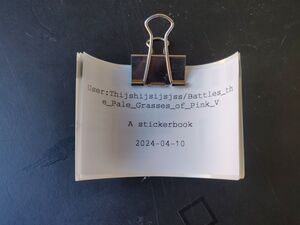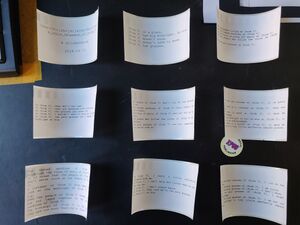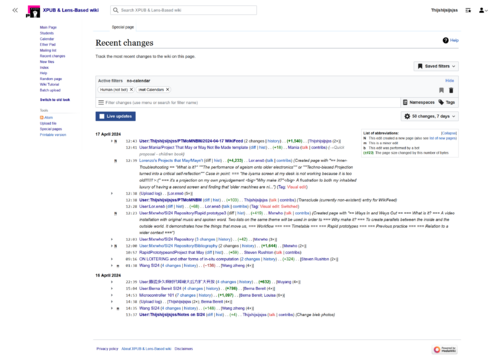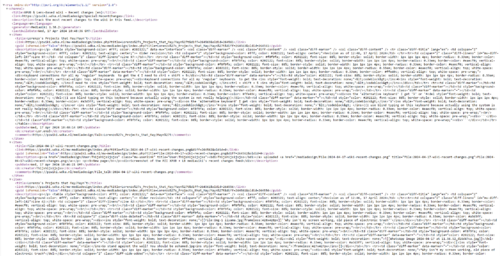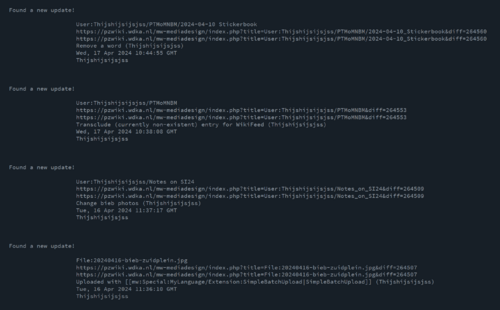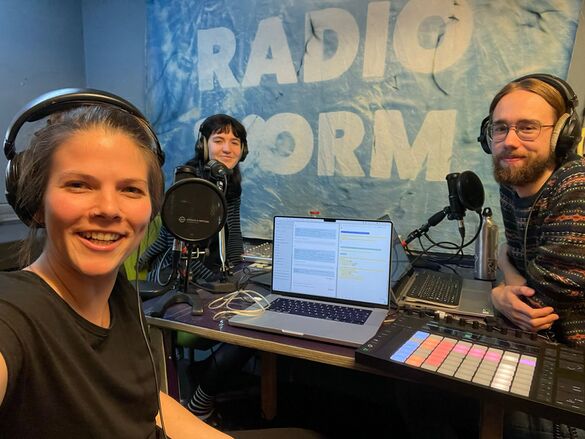User:Thijshijsijsjss/PTMoMNBM
A repository of projects that may or may not be made.
Prompts
A living collection of Prompts That May or May Not Be Made Into a PTMoMNBM
- A video game that does not exist
Web-to-print and play- A series of album covers for a band that doesn't exist
- A short film narrated by a pen plotter (ref. Secret Signals by Rogier Arents)
- A real time animation by a pen plotter
- A pen plotted 3D movie (flipbook animation of plotted 3D renders)
- A short story (bundle) made with the 'axiomatic writing technique' (explored in this text)
2024-04-10 Stickerbook
What is it?
> A stickerbook: a small (pocket-sized) book with written text where each individual page is a sticker.
Why make it?
> What happens to a book with a missing page? If all pages are missing, is it still the same book? Is it still a book at all? How much is the narrative of a book contained in it's physical form? > There is a suggestion of these pages not having a 'proper' order, in the sense that they can be taken and rearranged if a reader so desires. > Sometime I want to share a page from a book, or remove one from the whole, or keep one with me. Additionally, I wonder what
Workflow
(> Zeroeth, research must be done into the method of stickerization: how might one make the stickers? How can these pages be bound together if so desired? Etc) > First, a text needs to be settled on. It can be an already existing text, or something new. > Next, the text needs to be formatted in a way to accomodate for the eventual stickerization. > Then, stickers need to be made. > Finally, optionally, the sticker-pages can be bound together.
Timetable
> The are two major factors in the timeline: 1. the text. If this text is to be created from scratch (maybe specifically for the purpose of this project), this will be the bulk of the work. 2. the stickerization. If this is done elsewhere (e.g. through an online service), shipping times should be taken into account. > All in all, the project should not take longer than 3 days (excl. shipping time): 1-2 to write, 1 to bind. If stickerization is done by self, this happens in between.
Rapid prototypes
A rapid prototype using this story made with the Brother QL-700 label printer.
Previous practice
> Building on questions of narrative and interaction in a static medium. Continuing explorations of printed matter.
Relation to a wider context
> It is a reference to stickerbooks that contain no text, but stickers figures.
Choices made
> Choices must be made on: * Page size * Fixed page size? * Include instructions? * Page numbers (yes or no) * ...
Talking with Mania, Victor and Zuzu
When someone finds a sticker, can they find the rest? (physical locations of other stickers? Link to full text?)
Alsmost becomes a game to find the rest of the book, like geochaching. Rewarding to find a sticker already, even without considering the contents of the text.
The sticker format implies a spatial format. The book is read 'in space'.
2024-10-17 WikiFeed
What is it?
An app for your mobile device reading RSS feeds from our community wiki. A user downloads and installs the app, logs in with any valid user account, and is able to select any type of feed they want to watch. They could do this in the app. Also, they can enable alerts, alerting them on specific wiki updates.
Why make it?
The wiki is a content feed. I notice myself checking the recent changes all the time, partially triggered by a feeling akin to 'doomscrolling'. In contrast to more conventional media platforms, a wiki is seemingly archaic, static, factual and 'uninteresting' to our dopamine dependent brains. WikiFeed comments on this.
Aside, it has practical use cases, too. Currently it is possible to view the revision history of specific pages on the wiki itself, and view a feed of recent changes. This is convenient information to have. However, sometimes you want this information outside of the wiki. For example:
1. A pop-up notification on your phone when a specific page is altered
2. Display up-to-date content from a specific set of pages
Workflow
[I'm unsure whether the intention for this section is describing the workflow making the project, or using the project. I will go for the former] The workflow consists of four stages: research, coding, designing, polishing. They are described in more detail in the Timetable section.
Timetable
1 day of research into the mediawiki api: what can we extract and how?
1 day of research into the development platform: what is a suitable suite for developping for mobile?
1 day getting familiar with this suite, playing around, prototyping some tests
2 day to get the core functionality working
- compiling feeds
- selecting feeds
- switching between feeds
- adding to feeds
2 days for the design
2 days for polishing and adding nice-to-have features
Rapid prototype
A very rapid prototype made with Processing, just to get a feel for extracting the feed through external software, and displaying it there.
XML xml;
void setup() {
xml = loadXML("https://pzwiki.wdka.nl/mw-mediadesign/api.php?action=feedwatchlist&wlowner=USER&wltoken=TOKEN");
//println(xml);
XML[] items = xml.getChildren("channel")[0].getChildren("item");
for (int i = 0; i < items.length; i++) {
println("Now printing a new item!");
String title = items[i].getString("title");
println(items[i].getContent());
println();
}
}
Previous practice
WikiBabble: a project that uses the community wiki as a messaging platform. It plays with the dynamics of personal and intimate chatting on an inherently public platform. WikiFeed can be an extension to this project, serving alerts like most instant messagers do. TL;DR: a project in which logged and unlogged activities of and surrounding the community server chopchop are compiled, annotated and displayed on an E-reader. In the making of this project, we considered using a collection of wiki pages to store information. This would have made use of the feature that any user can edit any page. Finally, I'm an avid user of this wiki, and would like to explore more possibilities with it. In particular, I have kept a diary that I have been told reads as quite intimate. WikiFeed could explore these 'intrusive tensions' even more.
Relation to a wider context
awef
Useful links:
Feed of USERNAME's watchlist: https://pzwiki.wdka.nl/mw-mediadesign/api.php?action=feedwatchlist&wlowner=USERNAME&wltoken=TOKEN TOKEN is obtained by logging in to the wiki > preferences > Watchlist > Manage tokens Feed of changes of a specific page: https://pzwiki.wdka.nl/mediadesign/PAGENAME?action=history&feed=rss e.g. https://pzwiki.wdka.nl/mediadesign/Main_Page?action=history&feed=rss Feed of all recent changes: https://pzwiki.wdka.nl/mw-mediadesign/api.php?action=feedrecentchanges&feed=rss
Talking with Alessia, Mania, Victor and Zuzu
- Could lean into the commentary aspect
- References on doomscrolling commentary?
- 'Reading feeds' can mean different things -> could operate an Arduino for example
- Collaborative?
2024-04-28 Pen Plotted Illustration Book
What is it?
An illustration book telling a story in about 12 spreads, handbound and all pen plotted.
Why make it?
I find illutration books to (try to be) be intimated experiences. However, their mass production and particular materiality often creates a distance for me that inhibits me from fully experiencing this intimacy. Glossy pages, hard covers. The illutration book becomes a pristine object that cannot and should not be damaged. Should not be interacted with in playful ways. All the while, often the the stories they portray allow for a sense of curiosity and wonder that text-based books sometimes lack. There is a dissonance between the playful attitude of the content, and the static pompousness of the format. A pen plotted illustration book can provide a more harmonic outcome. While there is cooperation with machine, there is still a handmade quality to pen plots. And due to the quirks of plotting, every plot is unique. As a method, it embraces playfulness (and seamfulness). Finally, such a book could highlights many techniques of pen plotting, and in that way also serve as a nice overview for someone interested in this practise.
Workflow
1. Make the story
1.1 Create a narrative
1.2 Create concept art for characters and environments
1.3 Create a storyboard
2. Make some decisions
2.1 Decide on the method(s) of illustration
-> For example, multicolor crosshatches, stippling, vector outlines, ...
2.2 Decide on the binding technique
-> For example, stapled, thread sewn, glue binded, ...
2.3 Decide on the issue size
3. Illustration files must be made
-> This can include drawing and coloring by hand, and converting this to pen plottable illustrations.
4. Pen plotting
5. Binding
6. Distributing
Timetable
Yet to be determined.
Previous practice and Rapid prototypes
I have a previous practise both in pen plotting and in storyboarding for illustration-based stories. I will pull from this to provide this proposal with prototypes. This project is supported by three prototypes: 1. A storyboard prototype. This storyboard I made in October 2022 and might serve as a basis for this illustration book. 2. A pen plotting prototype, to see what some of the pages might look like. For exampes for one specitic technique, see for examnple this page. 3. A binding prototype. For this, I don't have a prototype currently.
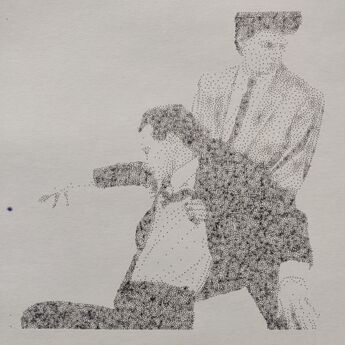
|
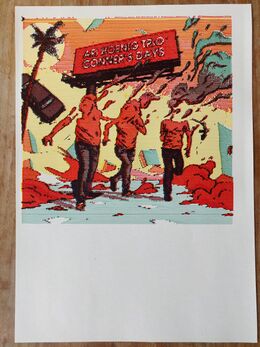
|
Relation to a wider context
This projects relate to the wider practise of pen plotting, and the multiplicity of methods and results they invite. There are few pen plotted publications, and a publication for pen plotted illustrations is, to my knowledge, novel. Additionally, we live in a society of fast paced consumption. In some ways, this behaviour is already being taught at a young age. Projects that cater to children should be aware of this.
Choices made
- story or 'fragmental'? - with or without text? - aimed at children, or not specifically?
2024-05-15 WORM Open Call
What is it?
A project of 3 months investigating through pen plotting the intersection between algorithms, obsolete media and community building in a series of 3 publications that are each accompanied by a release event at De Boog and a radio show at Radio WORM. It is a collaborataion with Alessia and Victor and will run from September to November of 2024.
Why make it?
Alessia and Victor and I have been experimenting with pen plotters over the past few months, establishing an experimental practise and finding these machines to be inviting for community building efforts. WORM / Amarte now has an open call with the theme 'algorithms' that aligns with our interests, and seems to allow for further investigation into our established and new methodologies alike. In a conversation about 'algorithms', it is important to consider the ecological aspects obsolete media (like pen plotters) confront us with, as well as the curious, performative and physical experience they provide.
Workflow and Timetable
There's a lot to flesh out for this project. As it is on spannign multiple months, and due to the nature of our methods, part of the fleshing should happen during the run of the project. This is hard to capture in a timeline. A very rough schedule of main events could be something like this:
* before September:
Commuinicating our visions with WORM.
Talking to the people from the other 3 projects.
Deciding on the content outlines for the publications, the focus.
* Start of September:
Setting up at De Boog.
Event launching the project
Optionally: a radio show launching the project
* End of September:
Event launching publication #1
Radio show #1
* End of October:
Event launching publication #2
Radio show #2
* End of November:
Event launching publication #3
Radio show #3
Previous practice
At XPUB, we have been experimenting with Pen plotters a whole bunch, investigating their multiplicity. For example: * User:Alessia/Pen_plotter_magic * User:ØverLørd/Complot * User:Thijshijsijsjss/Pen_Plotting_Panache Also, we have helped organise several events dedicated to pen plotters: * A Pen Plotting Party in Rotterdam, 2024-02-12. Website, photo documentation, video documentation. * A Pen Plotting Party in Brussels, 2024-05-04, in collaboration wtih OSP. website. Aditionally, we have experience with Radio WORM through SI22.
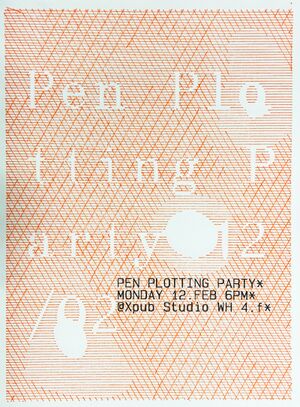
|
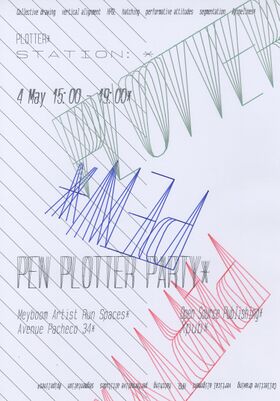
|
Relation to a wider context
Some of the wider context has already been discussed (including the community we are building around pen plotters). Additionally, there is WORM's community building efforts, and their support for independent creators. The open call we are applying to consists of 4 projects. Publishing (which we are applying to), exhibition, experimental performance and club night concept.
Choices made
* Radio shows before or after publications? * Publications (partially) made through community events?
2024-05-28 Web-to-Print and Play
What is it?
This project is a Print and Play game making use of Web-to-Print functionalities to provide a cutomizable experience. It is self hosted Most of this proposal focusses on the format, not the content of the game, which is yet to be decided upon.
Why make it?
Print-and-Play (PnP) is a genre of boardgames that are available for download, so that you can print it yourself. A large appeal of PnP games is their customizability: they allow (and often encourage) players to get crafty and (literally) built their own experience (example 1, 2). Usually this has aesthetic results, but there are examples of content-customization as well (for example Dungeon Pages, playthrough example). These customizations can give variety, provide control over difficulty settings and stimulate replayability. However, there are limits to this customizability. People are restricted to their printed matter, and for content customizations are dependent on what is served to them by the creator. Web-to-Print provides a solution to this: through a web-interface, players can achieve even more fine-grained control over their experience, by allowing for pre-print customizations (both cosmeticor gameplay tweaks). This web-interface could even provide a multimedia experience typical PnP games don't allow for, like an accompanying soundtrack. Finally, there are also games possible new to the PnP realm, by the randomness that the pre-print steps provides. For example, assymetric games like KTaNE can be simulated. From a creator's point of view, this also gives rise to a nice way of self-publishing the game, of being in close contact with the players and of updating the game.
Workflow
Phase 1: Research and brainstorming
Playing some relevant PnP and video games, solo and with others
Like Utopia Engine, Keep Talking and Nobody Explodes, ...
Phase 2: Prototyping
Start forming the printed game
Explore and setup basic web-to-print pipeline
Phase 3: User testing and community outreach
Start user testing with the prototype(s) from phase 2
Pay special attention to possible tweakable metrics or features by the players
Look for places to promote the game (e.g. look to which subreddits other creators post)
Phase 4: Creation
Finalize game design
Create necessary assets not yet made in phase 2 and 3
Create web-interface based on the parameters found in user testing
Otional: Collaborate with others
E.g. a soundtrack could be made in collaboration with a musical artist.
Phase 5: Tweaking and launch preparations
Timetable
There is a big range to this project. A bite-sized project might require but a weak, a larger project might require a month or more of full-time work. Though I'd like it not to take up much more than that. [this timetable can be fleshed out more if this P will be M rather than NBM]
Rapid prototypes
Previous practice
This projects could prove to be a nice way to connect old and new occupations of mine: (digital) game making and print making explorations. I have made many small games before, both digital and physical, and some of these have been self-hosted and distributed (others used itch.io or usb handovers).
Relation to a wider context
Resources and references
* Dedicated subreddit * One of many online PnP stores (with many free games) * Shut Up & Sit Down video (Vegan content warning for first 20 seconds) * boardgamegeek.com's page on PnP with links and resources
Roll and write games have come full circle, and many PnP games are heavily inspired by video game content and UI. For example, Utopia Engine mimics pop-up menu's from video games by sliding sheets of paper over each other.
Choices made
2024-05-29 Pen Plotted 3D Movie
What is it?
This project concerns a 3D movie that consists of non-digital, all-pen plotted frames: a large 'flipbook' with offset images that are plotted in red / cyan, so that a 3D effect emerges when one looks at the moving frames with 3D glasses. The movie conerns a yet to be decided on topic. It will most likely last no longer than 5 seconds (assuming 'intended' revolution speed of flipbook). The movie is then accompanied by a screening
Why make it?
Workflow and Timetable
TBD
Rapid prototypes
Previous practice
This example project is not mine, but Alessia's. I think it conveys the potential in pen plotted animations well:
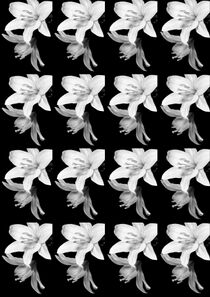
|

|

|
Find Alessia's dedicated project page on pen plotted flipbooks here
Relation to a wider context
3D film obviously has a long history. There have been many attempts to simulate 3D effects, one of which being the flimsical red/blue glasses. A nice entry point into some more experimental 3D effect is this Tom Scott video on the Pulfrich effect. Flipbooks, as well, have a long history. In our case, the mutoscope might be of interest. With Joseph, I looked at a project that projects 3D renders to 2D vectors. This is part of a larger research endeavor of ours to create software for SVG to HPGL conversion.
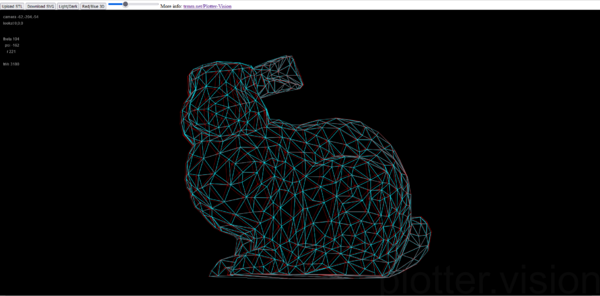
Choices made
The most impactful decision for this project is whether or not the frames should be digital or not. Physical frames mean: * a physical device is needed to show the animation * the 3D effect will be more difficult to convey, as the frame transitions aren't as smooth as for digital frames * the length of the film is greatly limited (to that of the carousel that holds the frames) * it is a For these reasons, a similar project but with digitized pen plotted frames should be considered also. However, there is an important reason to go for physical frames: the nature of pen plotting. Part of the allure of these devices is their (performance through their) mechanical nature. A physical screening can be an extension of this.
2024-07-?? Only Tape is Reel
User:Thijshijsijsjss/PTMoMNBM/Only Tape is Reel
2024-07-16 Unnamed Robot Doodling Project
What is it?
This project is a digitally self-published collection of robot drawings, each accompanied by a short text, that abstractly explore the disassociative effect mental illness can have. Though there is no current intention for a storyline, the collection can be seen as a comic. The comic is published on Instagram, one new drawing and text every day, for 25 days.Unnamed Robot Doodling Project is, as of yet, an unnamed project. Suggestions are welcome.Project title: jitterbots jitter - a sense of panic or extreme nervousness jitter - the variation in time delay between when a signal is transmitted and when it's received over a network connection
Why make it?
Currently, it is summer break -- a notoriously difficult time for me. I struggle with the transition to a mode of living with more agency over time allocation, and, in a bad spell of mental health difficulties, feelings of overwhelming anxiety and emptiness seem unavoidable. It is in these moments that I often reach for distractions -- often media consumption. This only perpetuates and often worsens my condition, and I find myself trapped in an every-growing maelstrom of paralyzing thoughts. So, lately, I try to apply the following strategy: any time I notice I'm overwhelmed and frantically flailing for a distraction, I draw a little robot instead. This is an activity I find relaxing, and in which I can find a glimpse of a sense of self. I have a love for comics, and have found digital ones to be really inspiring. So, here I find myself with about a dozen of drawings a day, that are ripe for some poetic charm. If that isn't an excuse to make a comic, what is? I am not made for social media -- few things seem as stressful to me as voluntarily exchanging authenticity for banal optimizations to please an unseen but assumed audience of algorithms and people to project onto. However, this participation seems to be a necessary evil for the independent artist. I figure I need some social media literacy. In fact, as much of my current mental health problems are concerned with questions of fading identity, I hope this will prove to be a positive challenge, one that is also harmonious with the contents of the comic. Therefore, I intend to publish this comic on the much dreaded Instagram.
(This project, unlike most of my PTMoMNBMs so far, is fueled not out of a desire to explore format, but rather a hope to process my inner world. In a way, I feel selfish for this, but my conversations with Senka and Zuzu have made me realize this is an area at the periphery of my comfortzone that is due for being explored.)
Workflow
The work for this project can be split into three parts: 1) Drawings: I have already described the workflow: whenever I'm faced with a moment of mental distress, I try to draw a little robot. I intent not to change this workflow. Although that is neither here nor there, as I've already produced sufficiently many drawings for this project. It is worth noting the the drawings are made with physical pen and paper. 2) Texts: These are created to accompany a specific robot, and therefore come after the drawing. As a stash of robots is already created, I intent to create text in batches. 3) Posts: I expect this to be stressful. Therefore, it is important to come prepared: at the time of posting, the drawing and text should already be prepared. This include scanning and pre-'post'-processing of the image and having the text digitally available. Moreover, I will create a template for myself as not to lose my sanity in the post-optimization process.
Timetable
Before the project starts it 25 day run, at least 25 drawings and 10 texts should be produced. Then, one drawing is posted every day together with one accompanying text. The time of posting is variable.
Rapid prototypes
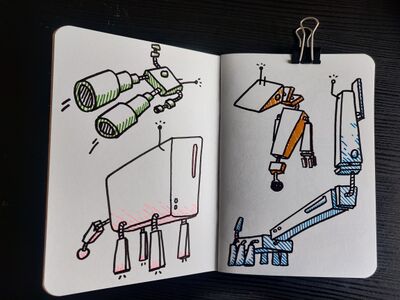
|
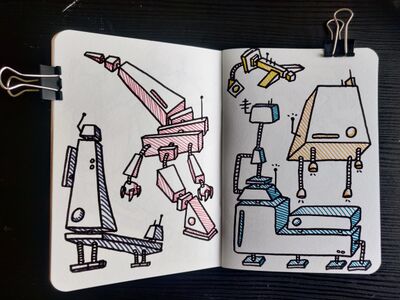
|
Previous practice
I have endeavored into multiple comic projects before, like this one. I have also experimented with multiple forms of (fragmented) storytelling -- be it in (not so) traditional stories, games, ... --- and have worked with themes of mental illness and disassociation before.
Relation to a wider context
Follows a tradition of alternatively published comics, like Tom Sidell's classic Gunnerkrigg Court or Maarten van der Meer's more recent Freddy. Instead of serialized chapter releases in a magazine, for example Weekly Shōnen Jump, these example both have a regular output of single pages or panels. This is made possible due to them being independently published. There are major platforms for this, like Webtoons, though these typically mimic a traditional publisher anyway. In the case of Gunnerkrigg Court, even a custom website is self-hosted[1]. A comic project that was similarly created as an exploration of mental health issues, is 100日後に死ぬワニ (This Croc will Die in 100 Days), self-published on the platform formerly known as Twitter 2019-2020. This project is fascinating on several accounts, one being the 'John Dies at the End'-factor: every page features a countdown of the days Croc has left to live, and this impending fate it often used as an explicit framing device for that day's comic page. (I was able to read this comic as it was coming out, which was a special experience. Especially as the final pages were released in the first week of COVID lockdown) During Zinecamp 2023, I bought a zine (the details of which I will add here later).
Choices made
(elaborate on choices for...) * Platform * Release schedule * Duration * 'Commercialness' Additional choices along the way * At the time of creating the first post, I have created 63 robot drawings and 25 texts. This is enough to cover the predetermined length of 25 posts, and should allow me to create more drawings and texts at a comfortable pace, if I decide I want to continue for more then 25 posts.

